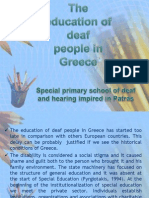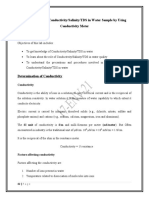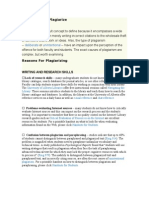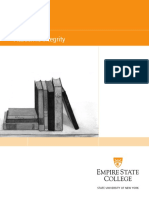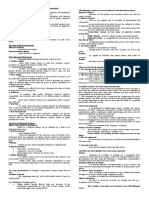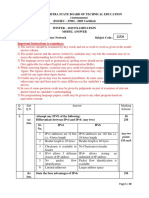What Is Plagiarism
What Is Plagiarism
Uploaded by
hi2joeyCopyright:
Available Formats
What Is Plagiarism
What Is Plagiarism
Uploaded by
hi2joeyOriginal Title
Copyright
Available Formats
Share this document
Did you find this document useful?
Is this content inappropriate?
Copyright:
Available Formats
What Is Plagiarism
What Is Plagiarism
Uploaded by
hi2joeyCopyright:
Available Formats
WHAT IS PLAGIARISM? Many people think of plagiarism as copying another's work, or borrowing someone else's original ideas.
But terms like "copying" and "borrowing" can disguise the seriousness of the offense According to the Merriam-Webster Online Dictionary, to "plagiarize" means -to steal and pass off (the ideas or words of another) as one's own to use (another's production) without crediting the source -to commit literary theft -to present as new and original an idea or product derived from an existing source. In other words, plagiarism is an act of fraud. It involves both stealing someone else's work and lying about it afterward. Example All of the following are considered plagiarism: -turning in someone else's work as your own -copying words or ideas from someone else without giving credit -failing to put a quotation in quotation marks -giving incorrect information about the source of a quotation -changing words but copying the sentence structure of a source without giving credit -copying so many words or ideas from a source that it makes up the majority of your work, whether you give credit or not (see our section on "fair use" rules) Most cases of plagiarism can be avoided, however, by citing sources. Simply acknowledging that certain material has been borrowed, and providing your audience with the information necessary to find that source, is usually enough to prevent plagiarism. WHAT HAPPEN IF WE PLAGIARIZE? http://123phimhay.com/movie-info/lustful_secretary-287.html When faculty members discover plagiarism, they may choose between simply penalizing the student themselves or reporting the plagiarism to College administrators, who will determine the penalty. Faculty members make such choices at their own discretion, depending upon the circumstances of each case. It is possible for a student to be penalized both by the faculty member and by administration. In general, the severity of the penalty matches the severity of the plagiarism.
An incomplete list of some common penalties imposed by faculty (used alone or in combination): Lowering a student's grade on the assignment Giving the student a failing grade on the assignment
Lowering the student's overall course grade Giving the student a failing grade in the course Things to keep in mind: The most serious forms of plagiarism (downloading an entire paper from the Internet, having someone else write the paper, copying the whole paper from some other source or sources) frequently result in the most serious penalty (dismissal). Even the least serious forms of plagiarism (e.g., improperly documenting a quote) result in some sort of penalty from the faculty member.
HOW TO AVOID PLAGIARISM? 1. Explain What "Plagiarism" Means Of course, most students will tell you they already know what plagiarism means. But do they really understand the difference between a legitimate paraphrase and a plagiarized one? Or between a proper citation and an improper one? Spending some time during the beginning of the course to explain plagiarism may go a long way toward preventing future problems. (We recommend using our handout defining plagiarism.) You may also wish to distribute examples of plagiarism and legitimate citation, and then go over the differences together. This will clarify some of the common misconceptions about plagiarism and reduce the likelihood of "honest mistakes," while at the same time showing how serious you are about the issue. 2. Explain What's Wrong About Plagiarism Without instruction, it may be hard for your students to understand the seriousness of plagiarism. Their response is often, "How can copying some words actually hurt anyone?" But the reality is that plagiarism is an act of fraud. It involves both stealing another's intellectual property, and lying about it afterwards, claiming the paper as one's own. This undermines the principles of trust and respect that make education possible. But when they plagiarize, students hurt more than just their instructors and the person from whom they steal. They also hurt themselves, because they fail to acquire the research, analytic, and writing skills that they would have learned by doing the assignment honestly. Finally, plagiarism also victimizes those classmates who have legitimately earned their grades and degrees, and who will be competing with the plagiarizer for school admissions and jobs. 3. Start off with Clear Expectations First, let your students know you expect them to produce thoughtful, original work. Students are often under the illusion that the goal of their assignments is to collect the best information possible. Explain to them that while good research is critical, you are even more interested in their ability to transform the information they find into an original and persuasive argument than in their ability to come up with the most or best sources. The skills they learn in working to further the ideas and arguments of others are a valuable part of what they will take away from their assignments.
Knowing this may help them understand the value of original work. You may also want to establish some rules in advance: Should your students collaborate? Will you require separate "works cited" pages and bibliographies? How many sources will they be required to consult? How many sources will they have to include in their paper? Will online sources be sufficient, or would you like your students to find printed material as well? Starting off with clear guidelines will prevent most of the confusion that leads to unintentional plagiarism, and allow no excuses for the intentional kind. 4. Require Students to Submit Thesis Statements, Introductions, Outlines, or Drafts One of the best ways to ensure that your students' work is original is to check it during the process of composition. Since rough drafts, etc., are not as readily available for copying as finished papers, the simple fact that they have to submit one will encourage most of your students to produce original work. It often takes more work to forge these materials than it does to produce them originally. Also, if you have time to comment on what they submit, you can monitor how they respond to your feedback and whether their papers show the flexibility of works-in-progress. 5. Have the Students Annotate Their Bibliography Ask your students to summarize the content and usefulness of their sources in a few sentences. Be sure to tell them that copying library abstracts or blurbs from the backs of books is not permissible. Emphasize that the annotation has to be in their own voice and words, and should specifically discuss the relevance of the source to their research. This exercise should take no time at all for students who have done their work honestly. Plagiarizers, however, will find it considerably more difficult. 6. Assign Oral Presentations Have your students answer questions about the process of researching and developing their ideas. This is also an excellent opportunity to ask them specific questions about their papers, and to bring up passages that seem suspicious. Questions like "This quotation here is a little unclear. Could you tell me a little more about the article from which you got it?" can be very effective in determining how much work the student did without offending or seeming suspicious.
What have we learn from plagiarism We learn that we want to do your own best work and to credit the author of any work you quote, paraphrase, or use as a source of information.
You might also like
- The Nine Types of LeaderDocument289 pagesThe Nine Types of LeaderBory Ugi100% (2)
- The Education of Deaf People in GreeceDocument22 pagesThe Education of Deaf People in GreeceDimitris Sakkoulis67% (3)
- BFW3841 Credit Analysis and Lening Management AssignmentDocument1 pageBFW3841 Credit Analysis and Lening Management Assignmenthi2joeyNo ratings yet
- Independence and YouDocument2 pagesIndependence and Youhi2joeyNo ratings yet
- Determination of ConductivityDocument10 pagesDetermination of ConductivityDani MughalNo ratings yet
- HARVARD Mens Health 50 and ForwardDocument56 pagesHARVARD Mens Health 50 and Forwardluciana100% (2)
- All About Baguette and MacaroonDocument2 pagesAll About Baguette and MacaroonDaisy Abdul100% (1)
- Brown 1989 PDFDocument12 pagesBrown 1989 PDFpompoNo ratings yet
- THE ADVANTAGES AND DISADVANTAGES OF NANOTECHNOLOGY Ed PDFDocument7 pagesTHE ADVANTAGES AND DISADVANTAGES OF NANOTECHNOLOGY Ed PDFHareeshaNo ratings yet
- HYMES An Ethnographic PerspectiveDocument16 pagesHYMES An Ethnographic PerspectivelouiseianeNo ratings yet
- CurrenT and FuTure STaTe of EuroPean UnIDocument246 pagesCurrenT and FuTure STaTe of EuroPean UnIMarco Vinicio Guzman GamerosNo ratings yet
- Ψηφιακός Γραμματισμός ΣταΟπτικοακουστικά Μέσα Σε Διαδικτυακά Περιβάλλοντα ΜάθησηςDocument19 pagesΨηφιακός Γραμματισμός ΣταΟπτικοακουστικά Μέσα Σε Διαδικτυακά Περιβάλλοντα ΜάθησηςSofos LoisosNo ratings yet
- PlagiarismDocument44 pagesPlagiarismArshad KhanNo ratings yet
- Assignment On Plagiarism Business AdministrationDocument8 pagesAssignment On Plagiarism Business AdministrationAbdiel AbdullahNo ratings yet
- Dissertation Self PlagiarismDocument7 pagesDissertation Self PlagiarismWhoCanWriteMyPaperHartford100% (1)
- Plagiarism Definition: Has Plagiarism Been Getting Worse in Recent Years?Document4 pagesPlagiarism Definition: Has Plagiarism Been Getting Worse in Recent Years?Sbl IrvNo ratings yet
- Intended Learning OutcomesDocument29 pagesIntended Learning Outcomesyiuloi997023No ratings yet
- Anti-Plagiarism Strategies For Research PapersDocument10 pagesAnti-Plagiarism Strategies For Research Papersdwi puji septariniNo ratings yet
- Book of PlagiarismDocument16 pagesBook of PlagiarismFaheem AslamNo ratings yet
- Little Book of PlagiarismDocument10 pagesLittle Book of PlagiarismMai HeoNo ratings yet
- Tutorial Section 1 April 11 2022Document2 pagesTutorial Section 1 April 11 2022junainaibrahim02No ratings yet
- Plagiarism, Citation of SourcesDocument19 pagesPlagiarism, Citation of Sourcesmonsignorzhaiky23No ratings yet
- Plagiarism-Ma’Am Vee’s Discussion.pdfDocument56 pagesPlagiarism-Ma’Am Vee’s Discussion.pdfVanessa Joyce MaghuyopNo ratings yet
- Plagiarism DefinedDocument4 pagesPlagiarism DefinedHannah Pauleen G. LabasaNo ratings yet
- Plagiarism: in Fact, Academic Standards of Intellectual HonestyDocument2 pagesPlagiarism: in Fact, Academic Standards of Intellectual HonestyAbhilasha SinghNo ratings yet
- Avoiding Plagiarism A Guide For StudentsDocument41 pagesAvoiding Plagiarism A Guide For StudentsHibri HalimNo ratings yet
- Plagiarism PDFDocument6 pagesPlagiarism PDFحسنين غانم خضيرNo ratings yet
- Back To School TipsDocument16 pagesBack To School TipsRejoice MpofuNo ratings yet
- Term Paper PlagiarismDocument6 pagesTerm Paper Plagiarismc5nrmzsw100% (1)
- Understanding Plagiarism: Qaiser IqbalDocument32 pagesUnderstanding Plagiarism: Qaiser IqbalSabir HussainNo ratings yet
- Plagiarism and Vail: Universitas Sarjana Wiyata Taman Siswa 2013 / 2014Document16 pagesPlagiarism and Vail: Universitas Sarjana Wiyata Taman Siswa 2013 / 2014Bambang HuseinNo ratings yet
- Types of Plagiarism IDocument9 pagesTypes of Plagiarism IUdiana Puspa Dewi100% (1)
- Plagiarism - Tanaka PolicyDocument1 pagePlagiarism - Tanaka PolicyLeonardo CanoNo ratings yet
- Plagiarism - Types, Reasons, and ConsequencesDocument2 pagesPlagiarism - Types, Reasons, and ConsequencesImen AggouneNo ratings yet
- What Is Plagiarism in ResearchDocument5 pagesWhat Is Plagiarism in Researchprakash.omprakash.om1No ratings yet
- Plagiarism: Student's Name Institutional Affiliation Course Number and Name Instructor's Name Assignment Due DateDocument9 pagesPlagiarism: Student's Name Institutional Affiliation Course Number and Name Instructor's Name Assignment Due DateJohn WairegiNo ratings yet
- Dissertation Plagiarism PercentageDocument5 pagesDissertation Plagiarism PercentageCollegePaperWritingServicesLittleRock100% (1)
- Plagiarism is a-WPS OfficeDocument6 pagesPlagiarism is a-WPS Officeelishapatrick2022No ratings yet
- GNED 101 - Term Essay AssignmentDocument4 pagesGNED 101 - Term Essay AssignmentHarshini ShankarNo ratings yet
- Essay On PlagiarismDocument5 pagesEssay On Plagiarismsohan hazraNo ratings yet
- Plagiarism: Academic PunishmentsDocument2 pagesPlagiarism: Academic PunishmentsSumitAggarwalNo ratings yet
- Why Students PlagiarizeDocument5 pagesWhy Students PlagiarizeYasir JuttNo ratings yet
- What Is PlagiarismDocument6 pagesWhat Is PlagiarismQui BuiNo ratings yet
- Why Should Plagiarism Be Avoided by Students ?Document5 pagesWhy Should Plagiarism Be Avoided by Students ?Avinaash VeeramahNo ratings yet
- 1 Introduction: 1.1 Defining PlagiarismDocument29 pages1 Introduction: 1.1 Defining PlagiarismAshwani RajputNo ratings yet
- Academic PlagiarismDocument5 pagesAcademic PlagiarismAstrini Wulandari DewanthiNo ratings yet
- Ethics in Research: Ethical PrinciplesDocument20 pagesEthics in Research: Ethical PrinciplesJames Bryan M. PrimaNo ratings yet
- Plagiarism Detection Software - CheckForPlagDocument3 pagesPlagiarism Detection Software - CheckForPlagseocheckforplag0No ratings yet
- Plagiarism FinalDocument5 pagesPlagiarism Finalmhrafin04No ratings yet
- UCD Policy On Plagiarism and FAQDocument10 pagesUCD Policy On Plagiarism and FAQWeiwei ShuNo ratings yet
- Academic IntegrityDocument4 pagesAcademic IntegrityrkageNo ratings yet
- PlaigarismDocument2 pagesPlaigarismAshish RanjanNo ratings yet
- Plagiarism Is A Serious Academic OffenceDocument4 pagesPlagiarism Is A Serious Academic OffenceMachel GiftNo ratings yet
- PlagiarismDocument8 pagesPlagiarismJessica Cabildo CalbanNo ratings yet
- Potential Consequences For PlagiarizingDocument2 pagesPotential Consequences For PlagiarizingOluwatoyin EmiolaNo ratings yet
- PlagiarismDocument2 pagesPlagiarismSamin yasarNo ratings yet
- Student Guidance On PlagiarismDocument6 pagesStudent Guidance On PlagiarismamericaserverahmadNo ratings yet
- Plagiarism in Legal ResearchDocument6 pagesPlagiarism in Legal Researchmuwonge ukashaNo ratings yet
- DF 23Document23 pagesDF 23Dxtr MedinaNo ratings yet
- Plagiarism Exercise 3 PDFDocument5 pagesPlagiarism Exercise 3 PDFFerdausNo ratings yet
- Academic Integrity: Writing The Research PaperDocument10 pagesAcademic Integrity: Writing The Research PaperAlex ClarkeNo ratings yet
- How To Write Research Papers Without Being Called PlagiaristDocument29 pagesHow To Write Research Papers Without Being Called PlagiaristAyman HussienNo ratings yet
- Week 5 ARAW1 Academic Integrity-MinDocument60 pagesWeek 5 ARAW1 Academic Integrity-MinunalkadirNo ratings yet
- Plagiarism and CopyrightDocument15 pagesPlagiarism and CopyrightAbbas Yerima100% (1)
- PlagiarismDocument4 pagesPlagiarismAseem TanejaNo ratings yet
- Assignment PlagiarismDocument3 pagesAssignment PlagiarismNora HealeyNo ratings yet
- Loan Appraisal ReportDocument20 pagesLoan Appraisal Reporthi2joeyNo ratings yet
- Shareholder Elections of Audit Committee MembersDocument26 pagesShareholder Elections of Audit Committee Membershi2joeyNo ratings yet
- BFW3121 Tutorial Answers For Week 2 MoodleDocument2 pagesBFW3121 Tutorial Answers For Week 2 Moodlehi2joeyNo ratings yet
- BFW3121 Tutorial Answers For Week 3 (Semester 2, 2018)Document2 pagesBFW3121 Tutorial Answers For Week 3 (Semester 2, 2018)hi2joeyNo ratings yet
- BFW3841 Lecture Week 1 Semester 1 2018Document40 pagesBFW3841 Lecture Week 1 Semester 1 2018hi2joeyNo ratings yet
- BFW3841 Lecture Week 3 Semester 1 2018Document48 pagesBFW3841 Lecture Week 3 Semester 1 2018hi2joeyNo ratings yet
- Individual Due Date: 19 April 2019 (Week 7) : The Individual Assessment Task Consist Of: Part A: 10% Part B: 5%Document5 pagesIndividual Due Date: 19 April 2019 (Week 7) : The Individual Assessment Task Consist Of: Part A: 10% Part B: 5%hi2joeyNo ratings yet
- Accounting StudiesDocument51 pagesAccounting Studieshi2joeyNo ratings yet
- SHRIAcademyStudent Handbook - 10 Dec 2014Document46 pagesSHRIAcademyStudent Handbook - 10 Dec 2014hi2joeyNo ratings yet
- ACW2491 - 2018 S1 - WK 2 Lecture Solution TemplateDocument3 pagesACW2491 - 2018 S1 - WK 2 Lecture Solution Templatehi2joeyNo ratings yet
- Example 1 (Cum Dividend) : Acquisition AnalysisDocument3 pagesExample 1 (Cum Dividend) : Acquisition Analysishi2joeyNo ratings yet
- ACW2491 - 2018 S1 - WK 2 Lecture ExampleDocument2 pagesACW2491 - 2018 S1 - WK 2 Lecture Examplehi2joeyNo ratings yet
- Bose Marketing Project PDFDocument28 pagesBose Marketing Project PDFhi2joeyNo ratings yet
- Web Chages Enterprise Risk Management Profile - tcm3171-556690Document2 pagesWeb Chages Enterprise Risk Management Profile - tcm3171-556690hi2joeyNo ratings yet
- Acknowledgement & Agreement To Be Bound by The Terms of The Confidentiality AgreementDocument1 pageAcknowledgement & Agreement To Be Bound by The Terms of The Confidentiality Agreementhi2joeyNo ratings yet
- TDSR & MAS 632 (External) - 131210-2Document15 pagesTDSR & MAS 632 (External) - 131210-2hi2joeyNo ratings yet
- IRR Mental Health Act R.A. No.11036Document19 pagesIRR Mental Health Act R.A. No.11036TeacherEli100% (2)
- Barineau-TriumphEthicsDoubt-1994Document19 pagesBarineau-TriumphEthicsDoubt-1994claudedexter335No ratings yet
- 8 Bangladesh and Global Studies English Version PDFDocument138 pages8 Bangladesh and Global Studies English Version PDFNoel Martin50% (2)
- ★原作 - Blue Is the Warmest ColorDocument161 pages★原作 - Blue Is the Warmest Colorlah23846No ratings yet
- Lipids NotesDocument17 pagesLipids Notescsdeguzman7241pamNo ratings yet
- Sosiology of Law-Chapter 1 Definition, Definition and Characteristics of The Sociology of LawDocument62 pagesSosiology of Law-Chapter 1 Definition, Definition and Characteristics of The Sociology of LawDea TiaraNo ratings yet
- Reported SpeechDocument7 pagesReported SpeechMinh AnhNo ratings yet
- Uttar Pradesh Secondary Education Service Selection Board, PrayagrajDocument3 pagesUttar Pradesh Secondary Education Service Selection Board, Prayagrajaman mishraNo ratings yet
- DWWK ASSignment 10-7-23Document12 pagesDWWK ASSignment 10-7-23CWHNo ratings yet
- Pain ModuleDocument21 pagesPain ModuleBlake Kammin100% (1)
- Chapter Learning Objectives: After Studying This Chapter, You Should Be Able ToDocument13 pagesChapter Learning Objectives: After Studying This Chapter, You Should Be Able ToAkhil KalraNo ratings yet
- Core Java: Datatypes and VariablesDocument4 pagesCore Java: Datatypes and VariablesShiva CHNo ratings yet
- Internet Coffee Shop Marketing PlanDocument23 pagesInternet Coffee Shop Marketing PlanDaniel Camilo Granados FlórezNo ratings yet
- Aklatang Obrero - Ka Popoy - Working Class Hero PDFDocument2 pagesAklatang Obrero - Ka Popoy - Working Class Hero PDFAngelito Dela Cruz100% (2)
- 10 Great Books For Men PDFDocument6 pages10 Great Books For Men PDFJason Carter100% (1)
- Chapter 7 FinmarDocument2 pagesChapter 7 FinmarNathalie GetinoNo ratings yet
- Unit 4: by Héctor OrtízDocument8 pagesUnit 4: by Héctor OrtízIs MontañaNo ratings yet
- Antonio V. Raquiza For Petitioner. Cesar D. Javier For RespondentsDocument13 pagesAntonio V. Raquiza For Petitioner. Cesar D. Javier For RespondentsVicco G . PiodosNo ratings yet
- Construction of Mutual Gaze A Review of Studies On Male Gaze, Female Gaze, and Mutual GazeDocument5 pagesConstruction of Mutual Gaze A Review of Studies On Male Gaze, Female Gaze, and Mutual GazeTengeresz1969No ratings yet
- A Brief Overview: Minkul Tekwani, Muzammil Shadab MSRIT, BangaloreDocument18 pagesA Brief Overview: Minkul Tekwani, Muzammil Shadab MSRIT, Bangaloreminkul222100% (1)
- 22520-2019-Winter-Model-Answer-Paper (Msbte Study Resources)Document29 pages22520-2019-Winter-Model-Answer-Paper (Msbte Study Resources)ChuNo ratings yet
- Lampara de Hendidura Bi900Document2 pagesLampara de Hendidura Bi900yolitacosta83No ratings yet
- Project For Class 11 CBSEDocument7 pagesProject For Class 11 CBSEmecharenaofficialNo ratings yet
- FLS - Mining - Digital Services - Offerings - RELEASE 01 - May 2023 - DIGITALDocument22 pagesFLS - Mining - Digital Services - Offerings - RELEASE 01 - May 2023 - DIGITALDiego Lujan MendozaNo ratings yet
- PDF Expert GuíaDocument59 pagesPDF Expert GuíaJordan FonsecaNo ratings yet
- YARVIK XENTA 9.7 - TAB09-211 - Manual - MultilingualDocument452 pagesYARVIK XENTA 9.7 - TAB09-211 - Manual - MultilingualgmsbdenterNo ratings yet

